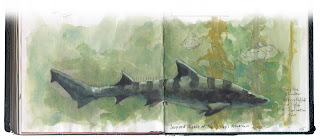
Relax. Do what I say and no one is going to get hurt.
A friend of mine, with theater experience, makes a wonderful point whenever he speaks to adults about creativity. “If you ask a room full of four-year olds, ‘How many of you know how to dance?’ they will all raise their hand. ‘How many of you know how to sing? How many of you know how to draw?’ etc. They will all raise their hand. But if you ask a room full of adults the same questions, only one or two individuals will raise their hand.”
I ask my college students on the first day, before their first drawing, “Have you ever noticed how you dance better after you’ve had a couple drinks? You’re not actually dancing any better. You just no longer care what people think about your dancing.”
I’m not advocating alcoholic consumption here, but with that in mind I ask my students to imagine they are in that same carefree state as they approach the first drawing exercises.
I would like to give you the same advice. Drawing is a wonderful activity. No one gets hurt. No one dies if you make a mistake. The worst that can happen is you do a bad drawing and feel a little embarrassed. In the big picture, that’s not so bad. Drawing is supposed to be fun. Not easy. It isn't without struggles and frustrations, but it is supposed to be fun. It's a great activity for the rest of humanity that doesn't like golf.
So start, and keep going. At every level, artists are still nervous; that feeling never goes away. So try not to worry. Relax. If you follow my instructions you really can’t do it wrong. Take a deep breath and GO! Believe it or not, this is the hardest thing I ask you to do in the entire book. If you can conquer your fears here and start drawing, you’re on your way. So get going! Draw anything. Draw what is in front of you right now, just to start yourself on the habit.
A Note About Perfection
If you cannot get past your need to be perfect at this, I’d like you to do the following assignment: Open your sketchbook to the next page. Scribble for 20 seconds, then mess it up more. Make the worst drawing you are capable of. Now make it even worse. See how bad it can get.
Feel better? It’s probably not even all that bad when you look at it, right? It might well be random, but is it bad? I doubt it. Now that this is out of your system, keep going, forget about perfection, and start having fun.
One Last Note About Fear
One of the best tricks for conquering your fears I learned from a book on procrastination, Doing It Now by Edwin C. Bliss. Promise yourself you’ll work for five minutes. If at the end of five minutes you want to stop, let yourself stop. In my experience, those five minutes usually become 30 minutes. It’s a great way to get started!
A friend of mine, with theater experience, makes a wonderful point whenever he speaks to adults about creativity. “If you ask a room full of four-year olds, ‘How many of you know how to dance?’ they will all raise their hand. ‘How many of you know how to sing? How many of you know how to draw?’ etc. They will all raise their hand. But if you ask a room full of adults the same questions, only one or two individuals will raise their hand.”
I ask my college students on the first day, before their first drawing, “Have you ever noticed how you dance better after you’ve had a couple drinks? You’re not actually dancing any better. You just no longer care what people think about your dancing.”
I’m not advocating alcoholic consumption here, but with that in mind I ask my students to imagine they are in that same carefree state as they approach the first drawing exercises.
I would like to give you the same advice. Drawing is a wonderful activity. No one gets hurt. No one dies if you make a mistake. The worst that can happen is you do a bad drawing and feel a little embarrassed. In the big picture, that’s not so bad. Drawing is supposed to be fun. Not easy. It isn't without struggles and frustrations, but it is supposed to be fun. It's a great activity for the rest of humanity that doesn't like golf.
So start, and keep going. At every level, artists are still nervous; that feeling never goes away. So try not to worry. Relax. If you follow my instructions you really can’t do it wrong. Take a deep breath and GO! Believe it or not, this is the hardest thing I ask you to do in the entire book. If you can conquer your fears here and start drawing, you’re on your way. So get going! Draw anything. Draw what is in front of you right now, just to start yourself on the habit.
A Note About Perfection
If you cannot get past your need to be perfect at this, I’d like you to do the following assignment: Open your sketchbook to the next page. Scribble for 20 seconds, then mess it up more. Make the worst drawing you are capable of. Now make it even worse. See how bad it can get.
Feel better? It’s probably not even all that bad when you look at it, right? It might well be random, but is it bad? I doubt it. Now that this is out of your system, keep going, forget about perfection, and start having fun.
One Last Note About Fear
One of the best tricks for conquering your fears I learned from a book on procrastination, Doing It Now by Edwin C. Bliss. Promise yourself you’ll work for five minutes. If at the end of five minutes you want to stop, let yourself stop. In my experience, those five minutes usually become 30 minutes. It’s a great way to get started!

